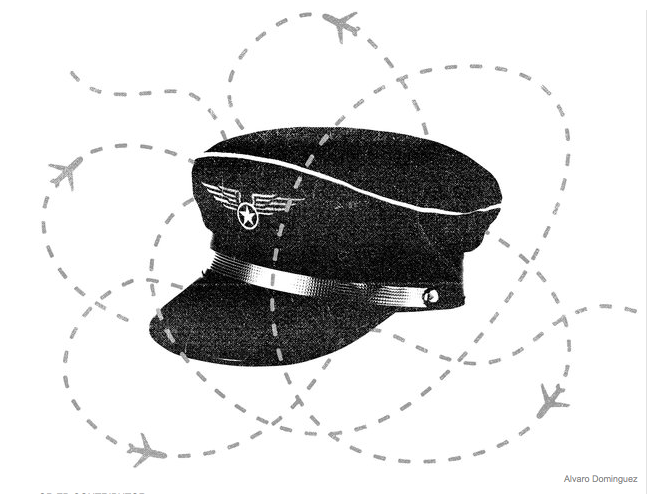Pilotless Planes? Not So Fast.
UPDATE: April 21, 2015
ON APRIL 10th, The New York Times published an op-ed of mine about cockpit automation and the future role of the airline pilot. This was my sixth op-ed to run in the Times, but easily my favorite, given my long-simmering frustration over the topic in question.
As my regular readers are aware, one of my biggest pet peeves is the public’s widely held belief that jetliners essentially “fly themselves” — the result of a too-gullible media that takes at face value the claims of researchers, professors and tech writers who, valuable as their work may be, often have little sense of the operational realities of commercial flying. Consequently, travelers have come to have a vastly exaggerated sense of the capabilities of present-day cockpit technology, and they greatly misunderstand how pilots interface with that technology.
In the actual newspaper they gave it excellent placement, center of the page, with a graphic showing a Chinese military hat being buzzed by mosquitoes. I’m right between David Brooks and Paul Krugman. Brooks is pretty well-known. Krugman won a Nobel Prize. Not sure what my big claim to fame is. I hope you’ll share the link with friends, and feel free to jump in and leave your thoughts in the Times‘ comments section.
Really the piece is less about the future role of pilots than it is about our current role. My main point being is that it’s pilots, not some computer, that is flying your plane. I only wish they’d give me more space. There’s plenty more to say on the subject. Since the Germanwings disaster, the cable channels, op-ed pages and blog sites have been chattering away about the supposedly diminishing role of human beings in the cockpit.
For instance there was Flying magazine’s Peter Garrison writing in the Los Angeles Times. “From shortly after takeoff to shortly before touchdown,” explains Garrison, “airplanes fly themselves while pilots talk with controllers and one another and punch data into flight management systems.”
That’s up there among the most insulting and misleading characterization of how commercial airplanes are flown ever to appear in print. Garrison is an experienced pilot and should know better than to reinforce this pervasive mythology through such flip and deceptive descriptions. Pilots become their own worst enemies sometimes, not realizing how statements like this are interpreted by the public.
Not to be outdone was John Cassidy on the New Yorker website. “In some ways, human pilots have become systems managers,” Cassidy says. “They prepare the aircraft to depart, execute the takeoff and landing, and take the controls in an emergency. But for much of the time that a routine flight is in the air, a computer flies the plane.” That was good of him to remind us that pilots indeed “execute the takeoff and landing,” which is to say they perform them by hand, but the rest of it is more of the usual nonsense.
The photo accompanying Cassidy’s story shows a simple button marked “autopilot.” I’m not sure what that blue button is for, or what aircraft the picture is from, but the actual autoflight control panel on any jetliner is, suffice it to say, a lot more complex.
There’s more: In the Toronto Globe and Mail, reporter Paul Koring wrote an article called, “Aviation is Fast Approaching the Post-Pilot Era.” He quotes David Learmount, a “veteran aviation expert,” who predicts that “pilots won’t be in cockpits in 15 years but in an airline’s operations room, rather like the U.S. Air Force pilots flying Global Hawks [military drones].” What utter and shameless rubbish.
And my old friend Missy Cummings was at it again, this time fooling a reporter at CNN.com. “Pilots only spend three minutes per flight flying a plane anyway,” she spouts. That’s a disgusting and deceptive thing to say. What she might mean is that pilots spend a relatively little amount of time (though it’s more than three minutes) steering the plane by hand. But they very much are flying it for the entirety.
Occasionally, well-intentioned people will bring up U.S. Airways hero pilot Chesley Sullenberger as a good example of why pilots are still necessary. Point accepted, but still I don’t like this, because it implies that pilots are only valuable in the event of an emergency or some unusual circumstance. On the contrary, even the most routine flight remains a very organic, hands-on operation subject to almost limitless contingencies that require human input. Cockpit automation is merely a tool, and it needs to be told what to do, how to do it, when to do it and where. And though a pilot’s hands aren’t gripping the steering column for hours at a time, as it might have in the 1930s, they are manipulating, operating, and commanding the various systems and subsystems that carry you to your destination.
Here, let me give you a quick demonstration:
I was asked by somebody to talk them through a typical maneuver. A descent, for example. How would I descend my 767 from, say, 25,000 feet to seven thousand feet, with the autopilot on? Well, it’d happen as follows. This is going to be incomprehensible to most of you, but that’s part of the point:
After being cleared to the new altitude, in this case 7000 feet, I’ll first reach up and dial “7000” in the altitude window on the mode control panel. The other pilot will verify this. The next series of steps depends where exactly on the arrival profile we are, but it’s common to activate a VNAV descent using the DESCEND NOW prompt from the descent page of the FMS. Typically I’ll already have the page set up for maybe Mach .79 and maybe 315 knots. This will give you a pretty good rate of descent.
At around 11,000 feet or so, we need to slow down in order to hit the 250 knot restriction below ten thousand feet. You can let the plane do this on its own, in VNAV, but sometimes that carries you off the profile and creates more work, so I come out of VNAV by hitting the VERTICAL SPEED switch. The VS window opens and I dial it back to 1,000 feet-per-minute, or maybe less. The plane’s rate of descent immediately begins to slow. And the instant I hit the VERTICAL SPEED switch, the IAS window also opened, allowing me to set in 250 knots. The thrust levers come back and the plane decelerates.
Now, all I have to do is tweak the rate of descent until I safely hit 250 at or near the 10,000 foot target. I might use 1000 feet-per-minute initially, then reduce it to 500. Whatever it takes. Using the spoilers can be helpful here too (the rectangular panels that rise from the top of the wings). I may already have been using them earlier in the descent if VNAV wasn’t quite holding the profile, or if ATC seemed antsy, etc.
Then, at 10,000 feet and 250 knots, I select FLCH. The 250 knots is now locked in the window and the plane will now hold that speed. I can descend at idle, or use thrust to play with the vertical speed rate, speed-on-pitch style, depending. We’ll be issued several more altitude changes, and I’ll stay with FLCH the rest of the way down, at least until joining up with whatever instrument approach is being used. Some instrument approaches, though, are flown in VNAV, which I’ll reengage later, when it’s needed, and use the speed intervene function of the IAS control to maintain the approach and landing speeds.
And that’s just the altitude control. We’ll have a number of course changes as well, to be dialed in and flown using whatever methods are appropriate (LNAV, heading select, LOC or APP mode…)
And so on. So, why not have the autopilot do this? It is doing it. The autopilot has been on throughout this scenario. This is the automation at work. Point being: it’s the pilots, not a computer, that is controlling the operation. And this is why it is so infuriating when Missy Cummings says pilots are only flying the plane for three minutes.
Granted the 767 is an older plane. It was designed in the late 1970s. There have been a few minor upgrades to the plane’s avionics since then, but nothing major. The plane is still operated exactly as it was when the first 767s were delivered. Frankly, though, even on the newest models, the basics of cockpit automation haven’t changed that much in thirty or more years. The interface between pilot and technology on a 787 or an A350 isn’t drastically different from how it was on a DC-10 or an old 747-200 in 1972. And the Airbus A320, like the one in the Germanwings crash? Its platform technology was developed in the 80s.
People will speak of planes being “highly computerized.” In some respects that true, but not in the sense that people think, and in fact it’s pretty rare for a pilot to refer to any piece of cockpit equipment as a “computer.” That’s just not a word that we use. Obviously certain components are computerized, but look around the typical cockpit and what you’ll see are lots of levers, knobs and switches. Hands-on stuff. Even the most advanced flight deck is yet to have a QWERTY keyboard anywhere on board. Pilots still use an old, ABCD EFGH style keypad to enter data into the FMS or ACARS. Much of our allegedly high-tech equipment is clunky, old-fashioned and user-unfriendly.
To be clear, I’m not arguing the technological impossibility of a pilotless plane. Certainly we have the capability. Just as we have the capability to be living in domed cities on Mars. But because it’s possible doesn’t mean that it’s affordable, practical, safe, or even desirable. And the technological and logistical challenges are daunting to say the least.
To start with, it takes the better part of a decade to design, build, and test-fly a conventional commercial plane. Neither Boeing nor Airbus has a new aircraft platform currently under development, let alone one flyable by remote control.
Not only that, but pilotless planes would require a gigantic — and gigantically expensive — rebuilding of pretty much the entire civil aviation infrastructure, from a totally new air traffic control concept to the redesign of airports. How many hundreds of billions would that cost, globally? And that’s after developing a fleet of tens of thousands of aircraft that are safe and reliable enough for automomous operations. And you’d still need pilots to operate these aircraft from afar!
It’s not impossible, but it would be a hugely more formidable task than people are led to think.
As I write in the Times, though, it’s not the future that concerns me so much as the present. I’ll be long retired and probably long dead before anybody is zipping around on pilotless planes. What riles me up is the simple wrong-ness of so much of what people think they know about a profession that in fact they know very little about, how simple they think this concept would be to develop, and the smugness with which they pronounce pilots as all but obsolete. It really insults me. And the public, for its part, deserves an accurate understanding of how planes fly, and of what pilots actually do for a living.
SEE THE NEW YORK TIMES STORY HERE.
New York Times illustration by Alvaro Dominguez.
Patrick Smith is the author of COCKPIT CONFIDENTIAL.





